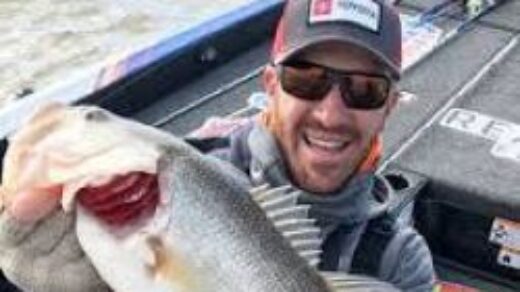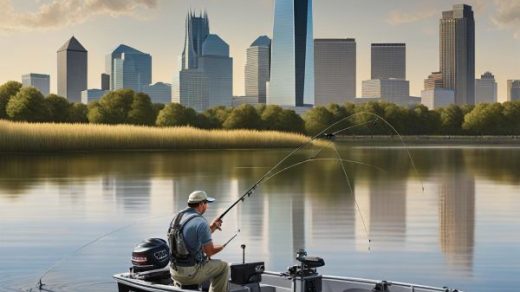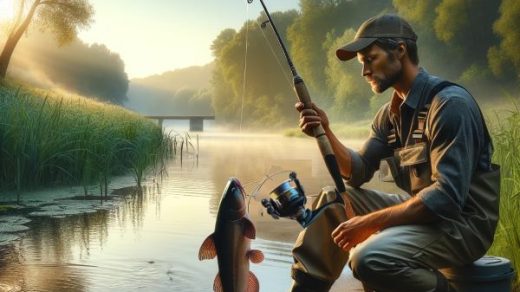The Changing Waters of Lake Powell: A Prelude to Adventure
As we set our sights on the fishing opportunities at Lake Powell, a jewel of the American Southwest nestled within the vast landscapes of red rock canyons, it’s crucial to begin with an understanding of the lake’s heartbeat: its water levels.
The fluctuating waters of Lake Powell not only tell the story of the region’s climate challenges but also shape the experiences of those who visit its expansive shores.
Recent years have seen Lake Powell’s water levels ebb and flow in response to the intricate dance of precipitation, runoff, and human management. These changes are a testament to the natural and man-made forces acting upon the Colorado River Basin.
For anglers, boaters, and nature enthusiasts alike, the water levels at Lake Powell are more than just numbers—they are a guide to navigating the possibilities and challenges of the lake’s vast aquatic playground.
Last year, on March 21st, 2023, Lake Powell’s water level was significantly lower compared to today, March 21st, 2024. Here’s a breakdown:
- This year (2024): 3,560.21 feet MSL
- Last year (2023): Around 3,521 feet MSL (based on news articles mentioning historic lows in February 2023)
There’s an increase of roughly 39.23 feet this year compared to last year.
For a more precise comparison, you can check the Lake Powell Water Database Lake Powell water data ON Lake Powell Water Database lakepowell.water-data.com which has historical data.
Before you pack your rods, reels, and hopes for the catch of a lifetime, it’s essential to seek out the latest information on Lake Powell’s water levels. This knowledge will not only ensure your safety and enjoyment but also deepen your appreciation for the delicate balance of natural resources we are privileged to enjoy.
As we embark on this exploration of Lake Powell’s fishing realms, let’s stay informed, adaptable, and respectful of the waters that connect us to this extraordinary landscape.
Is the fishing good at Lake Powell?
Lake Powell is renowned for its excellent fishing opportunities, making it a popular destination for anglers. The lake’s vast expanse, with its deep waters and myriad of coves and inlets, provides a rich habitat for a variety of fish species. Here are some key points about fishing at Lake Powell:
- Diverse Fish Population: Lake Powell is home to a variety of fish species, including largemouth bass, smallmouth bass, striped bass (stripers), walleye, crappie, catfish, and bluegill. This diversity offers anglers a chance to target different types of fish, depending on their preference and fishing techniques.
- Year-Round Fishing: The lake is accessible for fishing year-round, though the best times to fish can vary depending on the species. For example, spring and fall are often cited as the best seasons for bass fishing, while stripers can be caught throughout the year.
- Stunning Scenery: Apart from the fishing, Lake Powell’s breathtaking landscapes, with its clear blue waters contrasted against red rock canyons, make the experience even more enjoyable.
- Challenges and Rewards: Fishing in Lake Powell can be both challenging and rewarding due to the fluctuating water levels and the need to understand the habits of the fish in this unique environment. Knowledge about where fish tend to congregate, such as near structures or in deeper waters during the hotter months, can significantly improve your chances of a successful outing.
- Regulations and Conservation Efforts: It’s important to be aware of the local fishing regulations, which are in place to ensure the sustainability of the lake’s fish populations. These may include limits on the number of fish that can be kept, the size of fish, and specific rules for different species.
Given these points, many anglers find Lake Powell to be an excellent fishing destination, offering both a challenge and a rewarding experience. Lake Powell has something to offer if you’re an experienced angler or new to fishing.
What kind of fish are at Lake Powell?
Lake Powell is a haven for anglers due to its diverse fish population. The lake supports a variety of species that cater to different fishing techniques and preferences. Here are some of the primary types of fish you can find at Lake Powell:
- Striped Bass (Stripers): Perhaps the most famous residents of Lake Powell, striped bass are known for their size and the challenge they present to anglers. They can be caught using various methods, including trolling, bait fishing, and casting lures.
- Smallmouth Bass: Smallmouth bass are another popular target for fishermen at Lake Powell. They are known for their fighting spirit and are typically found around rocky structures and shallow waters.
- Largemouth Bass: While not as abundant as smallmouth bass, largemouth bass can still be found in Lake Powell. They prefer warmer, quieter waters, often near brush or other cover.
- Walleye: Walleye are prized for their taste and can be a bit more elusive, making them a rewarding catch. They are often found in deeper, cooler waters, especially during the summer months.
- Crappie: Crappie can be found in Lake Powell, particularly in areas with submerged brush or tree cover. They are a popular catch in the spring.
- Catfish: Both channel catfish and blue catfish inhabit Lake Powell. They are often targeted at night and can be found in various environments, from shallow flats to deeper channels.
- Bluegill and Other Sunfish: Bluegill and other panfish species offer a fun fishing experience, especially for families and beginner anglers. They can be caught with simple gear and are often found near shorelines and in protected bays.
The different kinds of fish you can find at Lake Powell and the preferred bait to use for each:
| Fish Species | Preferred Bait |
| Striped Bass (Stripers) | Live shad, anchovies, jigs |
| Smallmouth Bass | Crayfish, plastic worms, small lures |
| Largemouth Bass | Plastic worms, jigs, minnows |
| Walleye | Worms, minnows, jigs |
| Crappie | Minnows, small jigs, insects |
| Catfish | Stink baits, nightcrawlers, chicken liver |
| Bluegill | Worms, small jigs, insects |
This chart can guide you in choosing the right bait for a successful fishing trip at Lake Powell, targeting the specific species you’re interested in.
Each of these species offers a unique fishing experience at Lake Powell, making it a versatile destination that caters to a wide range of fishing preferences and techniques. Whether you’re after the thrill of catching a large striper or enjoying a leisurely day targeting panfish, Lake Powell has opportunities for all types of anglers.
Where is the fish cleaning station at Lake Powell?
At Lake Powell, you can find fish cleaning stations at various marinas, ensuring you have a convenient spot to prepare your catch. Specifically, Bullfrog Marina offers a range of services including a fish cleaning station. This marina, located in Utah, provides a wide range of amenities for boaters and fishermen alike, such as boat ramps, slips, gas stations, lodging, a campground, picnic area, marinas, grocery store, and a gift shop.
These facilities are part of the effort to make your fishing experience at Lake Powell as enjoyable and hassle-free as possible. Whether you’re returning from a successful fishing trip or just enjoying the water, these stations are designed to add convenience to your adventure. Remember to check the current operating hours and any specific regulations or recommendations before heading out, as these can vary by season and are in place to ensure both safety and sustainability.
Where is the best fishing at Lake Powell?
Finding the best fishing spots at Lake Powell can depend on the time of year, water conditions, and the type of fish you’re targeting. However, some areas are renowned for their fishing quality and scenic beauty, attracting anglers from all over. Here are a few spots known for excellent fishing at Lake Powell:
- Padre Bay: One of the largest bays on Lake Powell, Padre Bay offers diverse fishing opportunities, including smallmouth and largemouth bass, and is known for its stunning natural beauty.
- Bullfrog Marina Area: This area is convenient due to its accessibility and services, including a fish cleaning station. It’s a good spot for catching smallmouth bass, striped bass, and catfish.
- The San Juan Arm: This is a fertile area known for its abundance of smallmouth bass, largemouth bass, and crappie. Its remote location makes it less crowded, offering a peaceful fishing experience.
- Halls Creek Bay: Another excellent spot for smallmouth bass, Halls Creek Bay also offers opportunities to catch largemouth bass and walleye. Its clear waters and scenic backdrop make it a favorite among anglers.
- Warm Creek Bay: Known for striped bass and smallmouth bass, Warm Creek Bay provides ample fishing spots along its shores and deeper waters.
- Glen Canyon Dam Area: Near the dam, the deep waters are home to large striped bass and walleye. Fishing near the dam can be particularly good in the spring and fall.
- Dangling Rope Marina: Accessible only by water, this area is less pressured and can provide excellent fishing for striped bass and smallmouth bass. It’s also a good spot to refuel and restock supplies while on the lake.
Remember, the “best” spot can vary based on current conditions, fish behavior, and what you’re hoping to catch. Local marinas and fishing guides can offer up-to-date advice on where the fish are biting and which techniques are working best. Always check the latest regulations and have a valid fishing license for the area.
What is the best time of year to fish Lake Powell?
The best time of year to fish at Lake Powell largely depends on the species you’re targeting, but in general, fishing can be productive year-round due to the lake’s mild climate and diverse habitat. However, there are peak times for certain types of fishing:
- Spring (March to May): Spring is considered one of the best times for fishing at Lake Powell, as the water starts to warm up, and fish become more active and move into shallower waters. This is an excellent time for bass fishing, including both largemouth and smallmouth bass, as they are in pre-spawn and spawn periods.
- Summer (June to August): Fishing can be challenging during the hottest parts of the day in summer, but early morning and late evening can be very productive, especially for striped bass and catfish. Night fishing is also popular during the summer months to avoid the heat and catch catfish and bass.
- Fall (September to November): As the water begins to cool, fish become more active again, making fall another great time for fishing at Lake Powell. This period is known for excellent smallmouth and largemouth bass fishing. Striped bass also become more aggressive as they prepare for winter, providing good opportunities for anglers.
- Winter (December to February): Winter fishing can be surprisingly good, especially for striped bass and walleye, although you’ll need to be prepared for cooler weather. Fishing pressure is much lower during this time, which can lead to a peaceful and productive fishing experience.
While these are general guidelines, the best time for fishing can also depend on weather conditions, water levels, and other environmental factors. It’s a good idea to check recent fishing reports or contact local marinas for current information before planning your trip.
Does it cost to fish at Lake Powell?
Here’s a chart detailing the fees for different fishing licenses at Lake Powell, covering both Utah and Arizona.
These fees are approximate and subject to change, so it’s a good idea to verify the current rates through official state websites or local fishing authorities before making your purchase.
| License Type | Fee | Note |
| Utah Resident Fishing License | Approx. $34 (Annual) | Valid for 365 days from the date of purchase |
| Utah Nonresident Fishing License | Approx. $75 (Annual) | Valid for 365 days from the date of purchase |
| Arizona Resident Fishing License | Approx. $37 (Annual) | Valid for 365 days from the date of purchase |
| Arizona Nonresident Fishing License | Approx. $55 (Annual) | Valid for 365 days from the date of purchase |
| Utah 1-Day Fishing Permit | Approx. $16 | Only for nonresidents |
| Utah Multi-Day Fishing Permit (Additional Day) | Approx. $7 per day | Must be purchased with a 1-day permit |
| Arizona 1-Day Fishing License | Approx. $20 | |
| Arizona Short-term Combo Fishing & Hunting License | Approx. $15 per day | For nonresidents, includes both fishing and hunting |
Because Lake Powell spans the border between Utah and Arizona, you need to be aware of where you are fishing on the lake to ensure you have the correct state’s license. In some cases, anglers who plan to fish in both states may choose to purchase licenses from both Utah and Arizona to cover all areas of Lake Powell they wish to explore.
Is there another charge for entering Lake Powell?
In addition to fishing license fees, there are entry fees for accessing Lake Powell, which is part of the Glen Canyon National Recreation Area. Here’s a chart detailing these entry fees:
| Pass Type | Fee | Validity | Note |
| Private Vehicle | Approx. $30 | 7 days | Covers all passengers in a single, private, non-commercial vehicle |
| Motorcycle | Approx. $25 | 7 days | Covers all passengers on a single motorcycle |
| Individual (Bike, Walk) | Approx. $15 | 7 days | Per person fee for individuals entering by foot, bicycle, park shuttle, and for individuals traveling together in a vehicle as a non-commercial, organized group |
| Annual Pass | Approx. $55 | 1 year from month of purchase | Allows unlimited entry to Glen Canyon National Recreation Area for one year |
These fees are for entrance into the Glen Canyon National Recreation Area, which includes Lake Powell. They’re separate from any fishing license fees and are applicable whether you’re visiting for fishing, boating, or other recreational activities. The fees help support the maintenance and preservation of the park. Note that fees are approximate and subject to change, so it’s a good idea to check the latest information before your visit.
What if I’m having too much fun fishing and I want to camp is there camping at lake Powell?
Yes, Lake Powell offers numerous camping opportunities, ranging from developed campgrounds with amenities to more remote and primitive beach camping areas along the lake’s shoreline. Here’s an overview of the camping options at Lake Powell:
Developed Campgrounds
- Wahweap Campground: Located near the Wahweap Marina in Arizona, this campground offers RV and tent sites with amenities like restrooms, showers, laundry facilities, and a convenience store. It’s a great option for those looking for comfort while being close to the lake.
- Bullfrog Campground: Situated near the Bullfrog Marina in Utah, this campground provides RV and tent sites with access to similar amenities as Wahweap, including restrooms and showers. It’s an ideal base for exploring the northern parts of Lake Powell.
- Halls Crossing RV and Campground: Also in Utah, this facility offers basic RV and tent camping sites with access to the marina services at Halls Crossing, including a launch ramp, store, and restrooms.
Primitive Camping
- Shoreline Camping: Lake Powell is unique in that it allows shoreline camping in many areas along the lake, accessible by boat. This option offers a more primitive and adventurous experience, allowing campers to find their own secluded spot along the lake’s extensive shoreline. There are no facilities in these areas, so campers need to be self-sufficient and practice Leave No Trace principles to protect the environment.
Camping Fees and Reservations
- Developed Campgrounds: Fees vary by site and amenities. Reservations are recommended, especially during peak season, and can be made through the National Recreation Reservation Service or the marinas’ websites.
- Primitive Camping: Typically requires a fee for a camping permit, which can be obtained at the marinas or entrance stations. The permit system helps manage the impact on the environment and ensures campers follow the guidelines for waste disposal and campsite use.
Whether you’re looking for the convenience of a developed campground or the adventure of primitive beach camping, Lake Powell offers a range of options to suit different preferences. It’s always a good idea to plan ahead, check the latest conditions and regulations, and make reservations where necessary to ensure a smooth and enjoyable camping experience.
How about a boat? Can I fish from a boat? Are there any restrictions on motor size?
Yes, fishing from a boat is a very popular way to fish at Lake Powell. The lake’s vast size and the variety of fish habitats make it an ideal place for boat fishing. You can access deeper waters and more remote fishing spots that might be inaccessible from shore.
Boat Fishing at Lake Powell
- Boat Launches: There are several boat launches around Lake Powell, including those at Wahweap, Bullfrog, Halls Crossing, and Antelope Point marinas. These facilities provide easy access to the water for boats of various sizes.
- Boat Rentals: If you don’t have your own boat, boat rentals are available at the marinas. Options range from small fishing boats to larger houseboats, providing flexibility for different fishing needs and group sizes.
Restrictions and Regulations
- Motor Size: There are no specific restrictions on motor size for boats on Lake Powell. However, all boaters must comply with applicable safety regulations, including those concerning speed and operation near shorelines, marinas, and other boats.
- Safety and Environmental Regulations: Boaters are required to follow all safety regulations, including having the appropriate safety equipment on board. Additionally, efforts to prevent the spread of invasive species, such as quagga mussels, are taken very seriously. Boats must be clean, drained, and dry before entering Lake Powell to prevent contamination.
- Fishing Regulations: While fishing from a boat, you must adhere to the fishing regulations set by the states of Utah and Arizona, depending on where you are on the lake. This includes having a valid fishing license for the appropriate state and following all size and bag limit regulations.
- Boating Under the Influence: Operating a boat under the influence of alcohol or drugs is illegal and subject to strict penalties.
When planning to fish from a boat at Lake Powell, it’s essential to check the latest regulations from the National Park Service and state wildlife agencies. This ensures a safe and enjoyable experience while helping to preserve the lake’s natural beauty and fish populations.
Does it cost to fish from a boat?
Fishing from a boat at Lake Powell itself does not incur additional specific fees beyond the usual costs associated with boating and fishing there. However, there are several costs you should consider when planning to fish from a boat:
- Boat Launch Fees: If you’re launching your own boat, you may need to pay a launch fee at some marinas or boat ramps. This fee is typically separate from the entrance fee to the Glen Canyon National Recreation Area.
- Boat Rental Fees: If you don’t own a boat and plan to rent one, rental fees will apply. These fees vary depending on the type of boat (fishing boat, pontoon, houseboat, etc.) and the rental period (half-day, full-day, multiple days).
- Fishing License: Regardless of whether you’re fishing from shore or a boat, you need a valid fishing license from either Utah or Arizona, depending on where you are fishing on the lake. The cost of the license depends on your residency status and the duration of the license.
- Entrance Fee to Glen Canyon National Recreation Area: There’s an entrance fee for accessing Lake Powell, which is part of the Glen Canyon National Recreation Area. This fee is charged per vehicle or per person, depending on how you enter the area.
- Boat Fuel: Don’t forget to account for the cost of fuel for your boat, which can vary widely depending on the size of your boat and how far you plan to travel on the lake.
- Boat Inspection Fee: In efforts to combat the spread of invasive species such as quagga mussels, some locations may charge a fee for boat inspections or require a decontamination process, especially if you’re bringing a boat from outside the area.
- Camping Fees: If you plan to camp on the lake overnight in your boat (e.g., if you have a houseboat), camping fees or permits may be required, particularly for developed campgrounds or specific areas designated for camping.
It’s essential to budget for these costs when planning your fishing trip to Lake Powell. Prices and regulations can change, so it’s a good idea to check with the relevant authorities or marinas for the most current information before your trip.
Personal Experience: An Unforgettable Fishing Journey at Lake Powell
“Every year, I eagerly anticipate my vacation to Lake Powell, timing my visits for when the lake’s Fun session is just finishing and its less crowded. On one particularly memorable trip, we set up camp at the lake’s upper reaches near Hite—an area that promises both solitude and splendor. It was here, amidst the serene backdrop of towering canyons and expansive waters, that we embarked on our fishing adventure.
Casting our lines into the welcoming embrace of Lake Powell, we were graced by the lake’s rich diversity, encountering nearly every species it lake. From the spirited tug of smallmouth bass to the surprising heft of a walleye, each catch added to the tapestry of our unforgettable experience. Lake Powell, with its vastness and beauty, offered not just a fishing trip but a journey into the heart of nature’s bounty. It was a reminder of the joy and adventure that await in its depths, a testament to the enduring allure of Lake Powell’s waters.”






1 Response
[…] Located on the Colorado River, Lake Powell is the second-largest man-made reservoir in the United States. Famous for its deep, clear waters and dramatic red rock scenery, it’s a popular destination for boating, fishing, and water sports. Visitors can explore countless canyons, camp along the shore, or enjoy the luxury of houseboats. Here is a wonderful article about Lake Powell […]